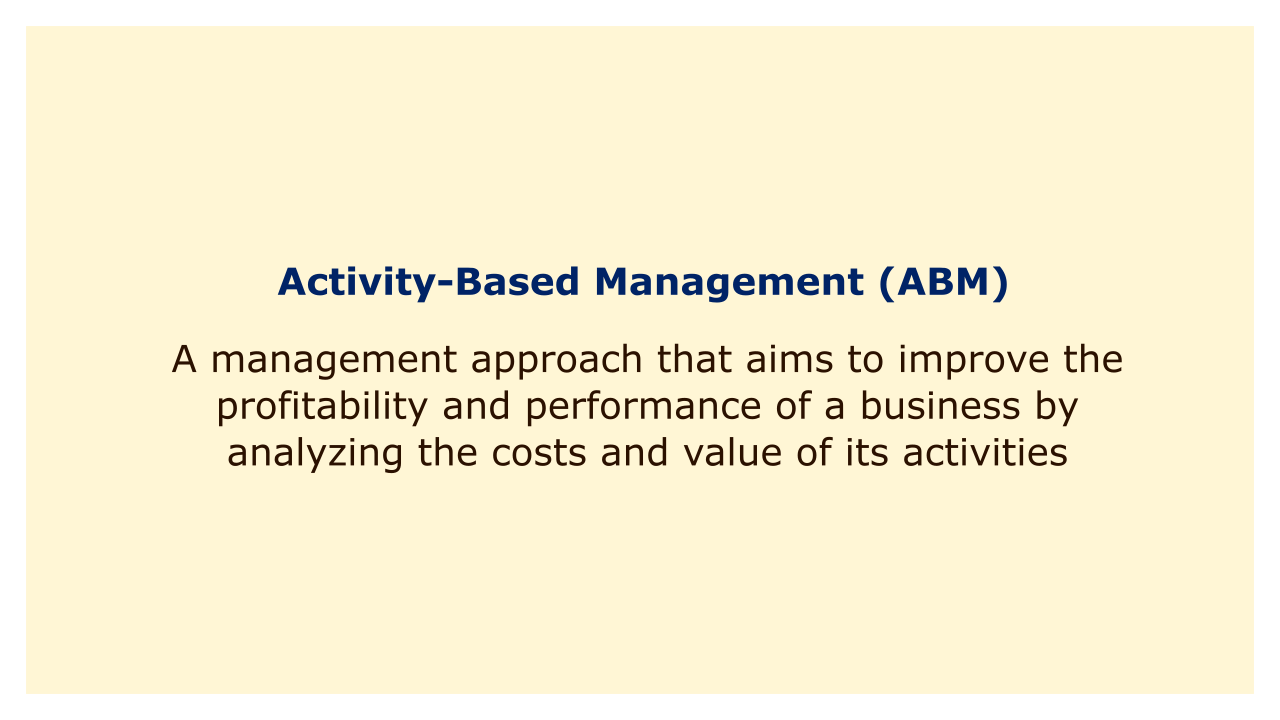 |
| Image: Moneybestpal.com |
Activity-Based Management (ABM) is a management strategy that looks at the costs and value of an organization's activities in order to increase profitability and performance.
ABM can assist companies with resource optimization, operational alignment with strategic goals, and the identification and elimination of unproductive or unprofitable activities.
ABM is important because it can help businesses:
However, ABM also faces some challenges, such as:
ABM is a potent management tool that can assist you in streamlining your company's operations, providing more value to your clients, and boosting profitability. You can find opportunities to increase your efficiency and effectiveness by using the ABC and VCA methodologies to examine the costs and values associated with your activities.
What is ABM and why is it important?
The foundation of ABM is the notion that business activities serve as the basic building blocks and that each activity uses resources and produces value for consumers. Managers can assess each activity's efficacy and efficiency and then decide how to improve it by analyzing its expenses and value.ABM is important because it can help businesses:
- Improve your knowledge of their procedures and cost factors.
- Decide which non-value-added tasks are wasting time, money, or quality and remove them.
- minimize overhead expenses and improve resource use
- Delivering additional value will increase consumer happiness and loyalty.
- Boost their profitability and competitiveness
How does ABM work and what are its steps?
Activity-Based Costing (ABC) and Value Chain Analysis are two complementing techniques used in ABM (VCA).
By using actual consumption data rather than artificial allocation bases, the ABC costing technique allocates the costs of resources to activities. About the prices of each activity, good, service, or client, ABC can offer more precise and thorough information.
A technique for analysis called value-chain analysis (VCA) analyzes the value-added activities that add value for customers throughout the entire process of delivering a good or service. The contribution of each operation to customer happiness, quality, differentiation, and profitability may be evaluated by management with the aid of VCA.
The steps of ABM are:
- Determine and evaluate important business activities. These are the activities that have a significant impact on costs, revenues, or strategic goals. Examples of activities include creating a product, buying supplies, putting pieces together, advertising a service, etc.
- Use ABC to determine the price of each activity. This entails analyzing the cost factors, such as the quantity produced, labor hours, number of orders processed, etc., that affect an activity's cost. Finally, depending on each activity's actual resource usage, assign the direct and indirect costs of those resources to that activity.
- Use VCA to calculate the worth of each activity. This entails identifying the value drivers—such as quality, speed, dependability, innovation, etc.—that produce value for customers. Then, evaluate each activity's value addition in terms of profitability, distinction, customer loyalty, or satisfaction.
- Do a cost-benefit analysis of each task to find areas for improvement. This entails assessing each activity's effectiveness and efficiency by contrasting its price to its worth. Afterwards, decide whether activities should be improved or stopped based on whether they are profitable or problematic.
What are the benefits and challenges of ABM?
ABM can provide several benefits for businesses, such as:- Better cost data for decision-making that is relevant and accurate
- Elimination of waste and errors improves process quality and efficiency
- Improved client value proposition through a focus on value-added activities
- Heightened operational adaptability and reactivity through a focus on changing client needs
- Linking activities to goals will improve strategic alignment and performance.
However, ABM also faces some challenges, such as:
- High implementation costs and the length of time needed for data gathering and analysis
- Identifying and monitoring activities, cost drivers, and value drivers can be challenging and complex.
- Employees and managers who may be afraid of losing their jobs or authority may be resistant to change.
- To maintain accuracy and relevance, there is a constant need to monitor and update processes and data.
How can you implement ABM in your business?
To implement ABM in your business successfully, you need to follow some best practices:- Include all parties that may be affected in the process, such as senior management, staff, clients, and suppliers.
- Transmit ABM's goals, advantages, expectations, roles, and responsibilities clearly.
- Ensure that the instruments for data gathering and analysis are properly trained and supported.
- Start by evaluating the viability and validity of ABM in a small portion of the business or as a trial project.
- Regularly monitor and assess the outcomes, and make any corrections.
ABM is a potent management tool that can assist you in streamlining your company's operations, providing more value to your clients, and boosting profitability. You can find opportunities to increase your efficiency and effectiveness by using the ABC and VCA methodologies to examine the costs and values associated with your activities.
